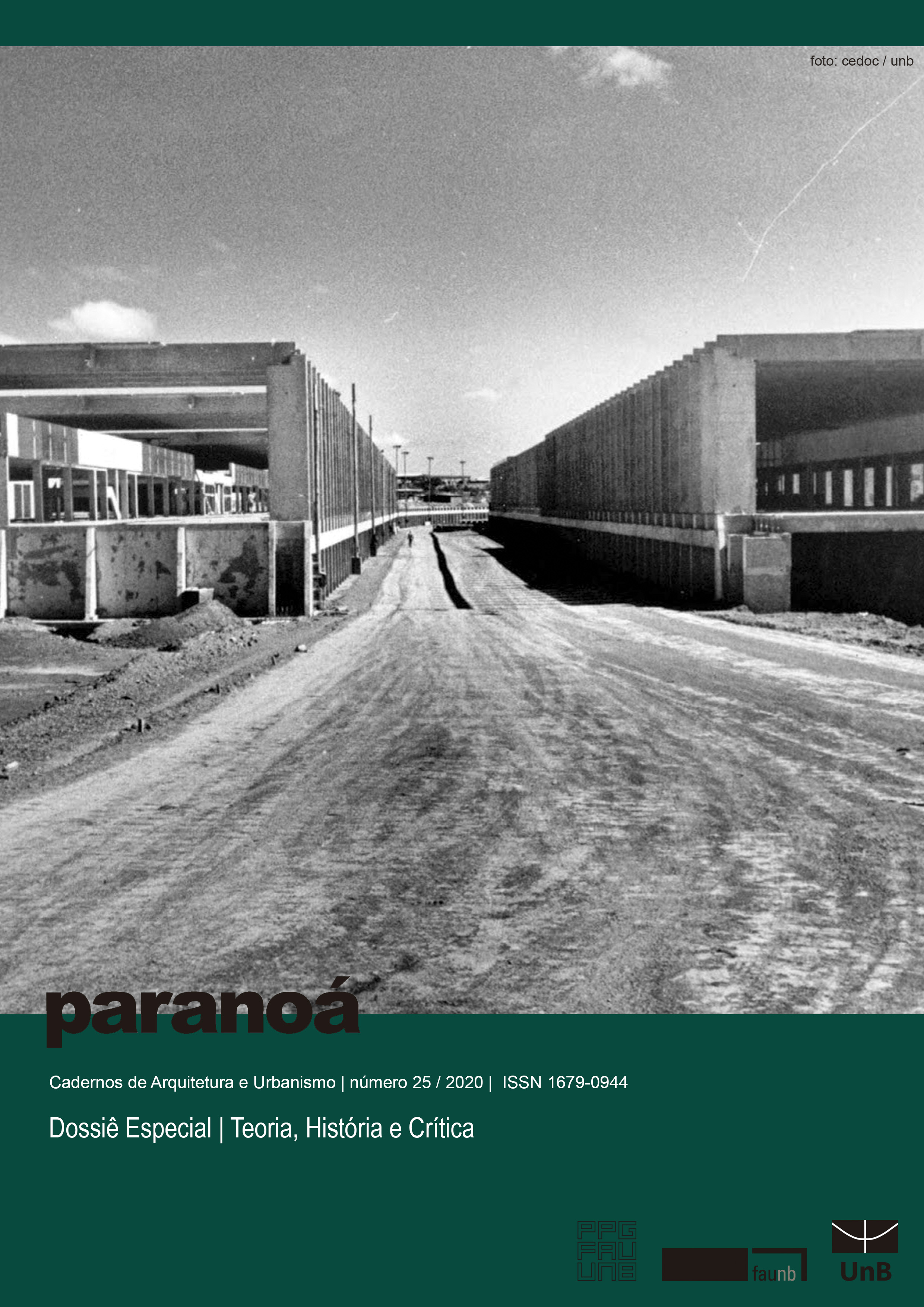Paths towards a Hermeneutics of Architecture
Analysis of Lindsay Jones' theory
DOI:
https://doi.org/10.18830/issn.1679-0944.n25.2020.11Keywords:
Theory; Hermeneutics; Architecture; Interpretation; Lindsay Jones.Abstract
Although hermeneutics is traditionally known as a methodology of textual interpretation, modern hermeneutics encompasses issues that involve not only written texts, but the interpretive process as a whole, including verbal and non-verbal forms of communication. The constitution of an architectural work presents historical and cultural interpretations, so buildings cannot be understood as an isolated object from the world and cannot be limited to an individualized interpretation. Thus, this article intends to analyze the concepts of the “hermeneutics of sacred architecture” conceived by Lindsay Jones in order to identify the potential of his theory for understanding the meanings of architectural works. It is deduced that the author's hermeneutic approach, by focusing on user interactions and experiences with the building and opposing the exclusively aesthetic apprehension of architecture, presents a new way of interpreting the meanings of buildings and provides important tools to ensure the democratic and heterogeneous character of the hermeneutic interpretation.
Downloads
References
GADAMER, H. Verdade e Método: Traços Fundamentais de uma Hermenêutica Filosófica. 3. ed. Petrópolis: Vozes, 1999.
GRONDIN, J. Hermenêutica. São Paulo: Parábola Editorial, 2012.
HOUAISS, A. Dicionário eletrônico Houaiss da língua portuguesa. Rio de Janeiro: Objetiva, 2009. (CD-ROM).
INGARDEN, R. Ontology of the work of art: the musical work, the picture, the architectural work, the film. Athens: Ohio University Press, 1989.
JONES, L. Eventfulness of Architecture: Teaching about Sacred Architecture is teaching about ritual. In: BELL, C. (ed.). Teaching Ritual. Oxford: Oxford University Press, 2007. p. 252 ”“ 272.
_________. Hermeneutical calisthenics: a morphology of ritual-architectural priorities. Vol. i.1, i.2, i.3, i.4. Chicago: Kazi Publications, 2016a. (The hermeneutics of sacred architecture: experience, interpretation, comparison).
_________. Monumental Occasions: reflections on the eventfulness of religion architecture. Vol. i.1, i.2, i.3, i.4. Chicago: Kazi Publications, 2016b. (The hermeneutics of sacred architecture: experience, interpretation, comparison).
KIDDER, P. Gadamer for architects. New York: Routledge, 2013.
NESBITT, K. Introdução. In: NESBITT, K. (ed.). Uma nova agenda para a arquitetura: antologia teórica (1965-1995). 2. ed. São Paulo: Cosac Naify, 2013. p. 15 ”“ 87.
NORBERG-SCHULZ, C. Intentions in Architecture. Cambridge: MIT Press, 1965.
PALMER, R. E. Hermenêutica. Lisboa: Edições 70, 2006.
PÉREZ-GÓMEZ, A. Hermeneutics as Discourse in Design. Design Issues. v.15, n. 2, p.71-79, Summer 1999
RICOUER, P. The model of the text: meaningful action considered as a text. New Literary History, v. 5, n. 1, p. 91 ”“ 117, Autumn 1973.
SARAMAGO, L. Espaço e obra de arte nos pensamentos de Heidegger e Gadamer. Artefilosofia, Ouro Preto, n. 1, p. 76 ”“ 93, jul 2006. Disponível em: <https://www:periodicos:ufop:br/pp/index:php/raf/article/view/797/752>. Acesso em: 04 fev. 2019.
SCHMIDT, L. K. Hermenêutica. Petrópolis: Vozes, 2012.
SNODGRASS, A; COYNE, R. Interpretation in Architecture: Design as a way of thinking. New York: Routledge, 2006.
________________________. Is Designing Hermeneutical? Architectural Theory Review, Sydney, v.1, n. 1, p. 65 - 97, 1997.
WAISMAN, M. O interior da história: historiografia arquitetônica para uso de latino-americanos. São Paulo: Perspectiva, 2013.
ZEVI, B. Saber ver a Arquitetura. São Paulo: Martins Fontes, 1996.
Downloads
Published
How to Cite
Issue
Section
License
Copyright (c) 2020 Paranoá: journal of Architecture and Urbanism

This work is licensed under a Creative Commons Attribution 4.0 International License.
Autores que publicam nesta revista concordam com os seguintes termos:
- Autores mantém os direitos autorais e concedem à revista o direito de primeira publicação, com o trabalho simultaneamente licenciado sob a Licença Creative Commons Attribution que permite o compartilhamento do trabalho com reconhecimento da autoria e publicação inicial nesta revista. http://creativecommons.org/licenses/by/4.0
- Autores têm autorização para assumir contratos adicionais separadamente, para distribuição não-exclusiva da versão do trabalho publicada nesta revista (ex.: publicar em repositório institucional ou como capítulo de livro), com reconhecimento de autoria e publicação inicial nesta revista.
- Autores têm permissão e são estimulados a publicar e distribuir seu trabalho online (ex.: em repositórios institucionais ou na sua página pessoal) a qualquer ponto antes ou durante o processo editorial, já que isso pode gerar alterações produtivas, bem como aumentar o impacto e a citação do trabalho publicado (Veja O Efeito do Acesso Livre).















